In the fast-paced world of technology, tablet stands have emerged as essential tools for enhancing the functionality of tablets in both personal and professional realms. These stands not only elevate the user experience by offering stability and optimal viewing angles but also cater to a wide array of applications—from digital artistry and culinary explorations to streamlined workflow solutions and interactive displays. With the continuous evolution of tablet technology, the need for stands that can accommodate various sizes, offer adjustable features, and ensure durability without compromising on design has become paramount. This importance is underscored further in settings where efficiency, convenience, and ergonomics are key, illustrating how a seemingly simple accessory can significantly impact daily operations and user satisfaction.
Table of Contents
1. Exploring types and uses of tablet stands
2. 2024 tablet stand market insights
3. Criteria for choosing tablet stands
4. Leading tablet stand models and features
5. Conclusion
Exploring types and uses of tablet stands

In the landscape of tablet accessories, stands serve as pivotal tools that enhance the functionality and usability of tablets across various settings. A deep dive into the types of tablet stands reveals two primary categories: adjustable and fixed, each catering to distinct preferences and requirements.
Adjustable vs. fixed stands
Adjustable stands: Adjustable stands are characterized by their versatility, offering users the ability to alter the height, angle, and orientation of the tablet. This flexibility is essential in settings where the tablet is used for multiple purposes or by different users, such as in shared workspaces, educational environments, or at home. The capability to adjust the stand ensures that users can find the most comfortable viewing angle, reducing strain and increasing productivity. Adjustable stands are particularly beneficial for creatives who rely on tablets for drawing or editing, allowing for an ergonomic setup that can adapt to various tasks.
Fixed stands: Fixed stands, in contrast, provide a stable and consistent base for the tablet, often used in settings where a single viewing angle suffices. These stands are favored in public spaces, such as for informational kiosks, point-of-sale systems, or as part of a static display in museums and galleries. The lack of adjustability is compensated by the robustness and reliability of a fixed position, ensuring that the tablet remains secure and in an optimal viewing position for the intended purpose.
Innovative designs for specific needs

The realm of tablet stands is marked by a surge in innovative designs, each tailored to meet specific user needs and enhance the versatility of tablet use across different scenarios. Among these, gooseneck, floor, and desk stands stand out for their unique benefits and adaptability to various environments.
Gooseneck stands: Gooseneck stands are celebrated for their unparalleled flexibility and precision. Characterized by their long, flexible arms that can be twisted and bent into numerous positions, these stands are a boon for users who require adjustability without compromising on stability. Ideal for hands-free operations, they allow tablets to be positioned at almost any angle, making them perfect for detailed artistic work, comfortable reading or viewing, and even for capturing videos or conducting video calls from unique perspectives. The sturdy base and adjustable grip ensure that the device remains securely in place, regardless of the angle.
Floor stands: Floor stands offer a different set of advantages, primarily their ability to elevate the tablet to various heights, making them ideal for presentations, lectures, or as information kiosks in public spaces. These stands can tower above the rest, ensuring that the tablet screen is visible from a distance, which is particularly useful in crowded environments or when the tablet is being used as a display in galleries or trade shows. The height adjustability feature ensures that the stand can cater to different viewing needs, from sitting to standing positions, enhancing the user experience.
Desk stands: Desk stands, on the other hand, cater to the everyday user looking to integrate the tablet seamlessly into their workspace. Designed to elevate the device to an optimal viewing level, these stands help reduce neck strain and improve posture by aligning the tablet screen with the user’s line of sight. Their compact design does not take up much space, making them suitable for crowded desks. Some desk stands also come with integrated charging ports, enhancing their utility by ensuring that the device remains powered throughout the day.
Portability and durability considerations

For users on the go, the portability of a tablet stand is a crucial factor. Adjustable stands, with their often collapsible designs, cater well to this need, allowing for easy transport and setup anywhere. Innovations in design have led to lightweight, yet sturdy stands that can be packed into a bag without adding significant weight or bulk. This portability extends the workspace beyond traditional settings, enabling professionals to set up an ergonomic workstation in cafes, libraries, or while traveling.
However, the durability of a tablet stand is equally important, especially for those frequently on the move. The materials used in the construction of the stand, such as aluminum, high-grade plastic, or reinforced silicone, play a significant role in its longevity and ability to withstand wear and tear. Durable stands not only offer better value for money but also ensure that the tablet is securely supported in all types of environments, from outdoor settings to busy public spaces. Manufacturers have responded to this demand by producing stands that balance lightweight portability with the strength needed to protect and maintain the tablet’s stability over time.
Each of these stands addresses distinct needs. This diversity not only underscores the importance of tablet stands in maximizing the utility of tablets across various applications but also highlights the thoughtfulness in design that goes into making technology more accessible and enjoyable to use. Whether for professional use, leisure, or anything in between, there’s a tablet stand design out there engineered to meet those specific needs.
2024 tablet stand market insights

Experts currently assess the worldwide tablets market is projected to generate a revenue of US$53.7 billion in 2024. This market is anticipated to experience an annual growth rate of 2.74% (CAGR 2024-2028), culminating in a market volume of US$59.9 billion by 2028. This growth trajectory underscores the sustained interest and investment in tablet technology and its accompanying accessories, reflecting their integral role in both personal and professional spheres.
Current trends and consumer preferences
The demand for tablet stands that are not only functional but also aesthetically pleasing has surged. Consumers are increasingly looking for products that blend seamlessly with their home or office decor, indicating a preference for designs that are sleek, minimalist, and made from high-quality materials. This inclination towards stylish yet practical accessories is driving manufacturers to innovate, resulting in tablet stands that are as much a statement piece as they are a utility item. Additionally, multifunctionality has become a significant selling point, with stands featuring built-in charging ports, adjustable components for various viewing angles, and compatibility with multiple device sizes to cater to the diverse ways tablets are used today.
Impact of remote work and learning

Within the context of the evolving dynamics of tablet stand usage, the profound impact of remote work and learning emerges as a significant driver of market trends and consumer behavior. The shift toward remote work has not only changed where people work but also how they interact with technology, subsequently influencing the demand for tablet stands. With 12.7% of the workforce transitioning to home offices and 28.2% to hybrid models as of 2023, the need for tablet stands that facilitate ergonomic, efficient workspaces has surged. This adaptation reflects a deeper integration of digital tools into daily routines, with an estimated 32.6 million Americans expected to work remotely by 2025. Such trends underscore the growing requirement for accessories that enhance the functionality of tablets, making them indispensable in a remote work setting.
Moreover, the broad adoption of remote practices across diverse industries, from IT and marketing to healthcare, underscores the versatility required of tablet stands. The widespread preference for flexible work arrangements—evidenced by 98% of workers desiring remote work options—highlights the importance of tablet stands that are not only functional but also adaptable to varied environments and uses. As sectors increasingly rely on digital platforms for collaboration and productivity, the demand for stands that can support prolonged use, facilitate video conferencing, and adapt to different settings becomes more pronounced. Consequently, the tablet stand market is innovating to meet these nuanced needs, driving forward designs that cater to the multifaceted ways in which tablets are now integral to professional and educational pursuits in a remote-first world.
As businesses navigate this landscape, staying attuned to these trends will be crucial in meeting consumer demands and leveraging opportunities for growth and innovation. The tablet stand market, with its blend of technology and design, offers a window into the future of how we interact with our devices, shaping the way we work, learn, and connect.
Criteria for choosing tablet stands
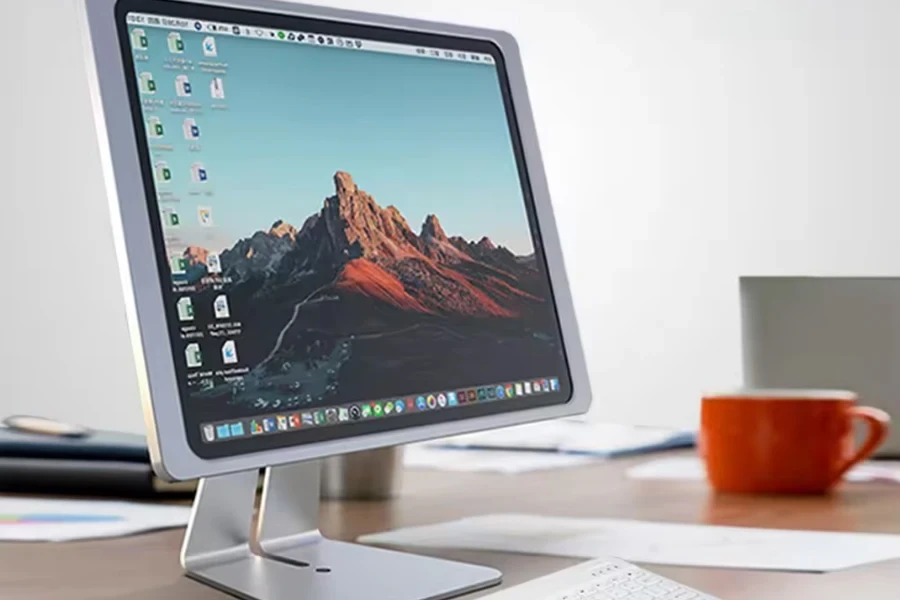
In the context of the evolving workplace and learning environments, the criteria for selecting the right tablet stands have become increasingly critical. This section delves into the essential factors to consider when choosing tablet stands, ensuring they meet the demands of contemporary usage.
Compatibility and flexibility
When exploring tablet stands, the breadth of compatibility across different device sizes stands paramount. For instance, adjustable stands that can securely hold tablets ranging from the compact 7-inch Amazon Fire to the larger 12.9-inch iPad Pro are invaluable. This wide compatibility ensures that whether for a personal device or various tablets used within a business setting, the stand can provide a universal solution.
An exemplary model in this context is the adjustable stand featuring an expandable clamp or bracket system. These systems can adjust to fit the specific dimensions of a device, often through a sliding mechanism paired with secure locks that safely accommodate tablets of various widths and thicknesses. Such designs cater to a spectrum of devices, not just in size but also in the protective cases they may be housed in, thus eliminating the need to remove the tablet from its case for stand use.
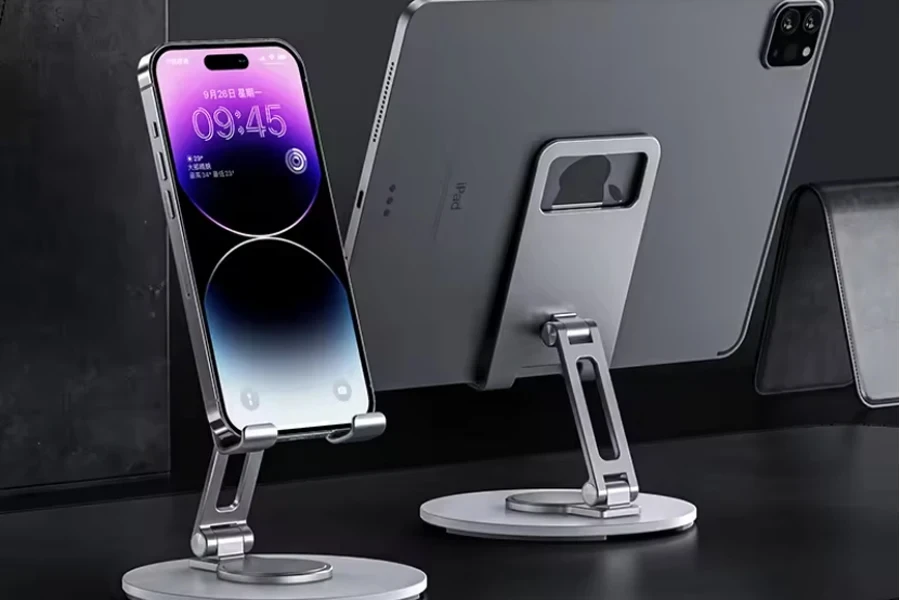
Flexibility in orientation adds another layer of complexity and necessity. The ability to switch between portrait for reading or video calls and landscape for media consumption or document review without compromising stability is a crucial feature. Rotatable stands, offering 360-degree rotation, exemplify this versatility, allowing users to effortlessly change the tablet’s orientation to suit the task at hand.
Moreover, the discussion extends to the stand’s adjustability in terms of viewing angles. A stand with multiple angle settings can significantly enhance viewing comfort and reduce glare, which is essential for prolonged use. For example, a stand offering tilt adjustments ranging from 0 to 180 degrees can cater to various ergonomic needs, promoting a healthier interaction with the device.
Incorporating these specific compatibility and flexibility features into the selection process of a tablet stand ensures that the chosen accessory maximizes the device’s utility. It not only accommodates the physical dimensions and preferred orientations of a wide array of tablets but also enhances user interaction by adapting to different use cases. These considerations are integral in selecting a stand that is truly versatile and user-centric, aligning with the dynamic ways tablets are integrated into daily activities and professional tasks.
Stability and security features
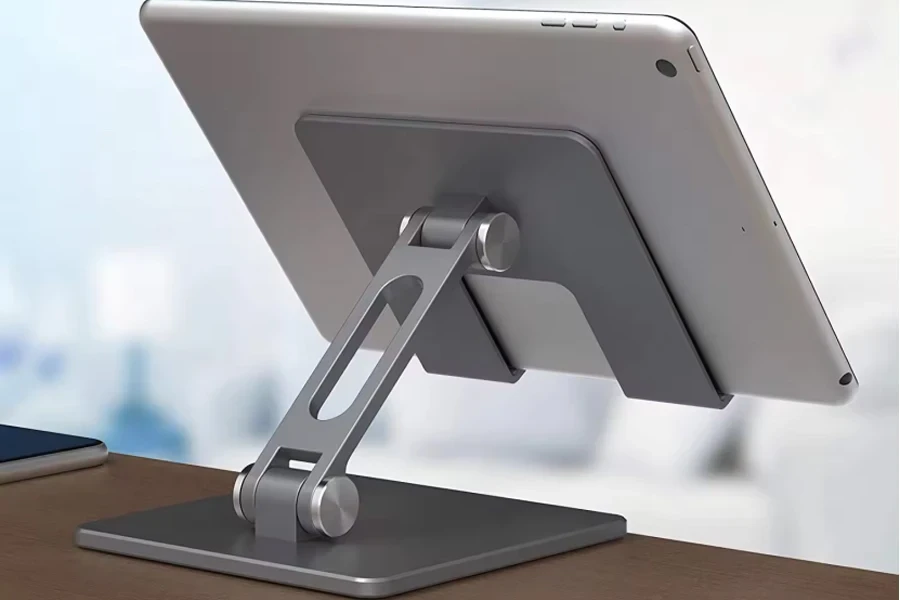
In selecting the right tablet stands, evaluating the mechanisms that ensure device safety and prevent slipping or falling is critical. These features are fundamental in protecting the device from accidental damage and ensuring it remains secure during use, especially in environments where movement or interaction with the stand is frequent.
A prime example of stability in tablet stands is found in models with weighted bases. These stands, often constructed from heavy-duty materials like steel or a dense alloy, ensure that the stand remains anchored, reducing the risk of tipping over when the tablet is touched or adjusted. For instance, a stand with a base weighing over 2 pounds (approximately 0.9 kg) significantly minimizes the risk of accidental knocks, providing a sturdy foundation for tablets of various sizes.
Security features in tablet stands often involve mechanisms like locking grips or clamps that firmly hold the tablet in place. These features are particularly important in public or shared spaces, where the risk of accidental or intentional removal of the device is higher. Stands equipped with adjustable clamps that securely embrace the tablet’s edges, coupled with anti-theft locking systems (such as Kensington locks), offer an added layer of security. These systems not only prevent the device from being dislodged from the stand but also deter theft, making them ideal for use in environments like libraries, classrooms, or retail settings.

Rubber or silicone pads are another notable feature that enhances both stability and security. Positioned where the tablet makes contact with the stand, these pads provide friction, preventing the device from sliding out of position. Moreover, they serve a dual purpose by protecting the tablet’s surfaces from scratches and abrasions. This detail is crucial for maintaining the device’s aesthetic and resale value, highlighting the thoughtful design of the stand.
The design of the tablet stand itself can also contribute to ergonomic benefits. Models with a curved or sloped design encourage a more natural hand and wrist position when interacting with the tablet’s touchscreen. This design feature helps reduce the risk of developing repetitive strain injuries (RSIs), which are common in users who perform prolonged typing or swiping actions.
Furthermore, stands equipped with features that promote ventilation, such as open-back designs or built-in cooling fans, address the issue of device overheating. By keeping the tablet cool, these stands prevent users from having to adjust their grip or usage patterns due to discomfort from heat, thus supporting sustained, comfortable use.
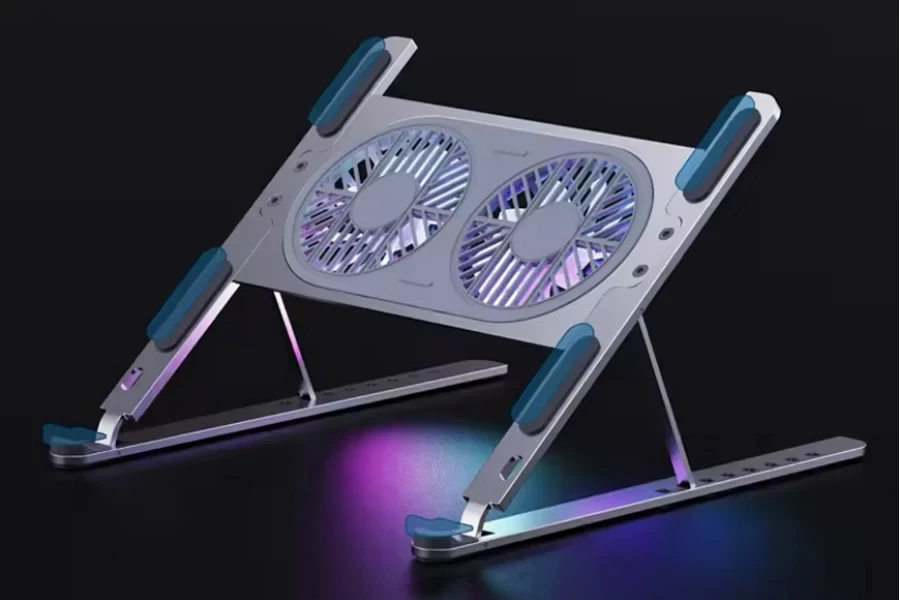
The inclusion of adjustable tension hinges or arms in tablet stands further exemplifies the integration of stability and security features. These components allow users to set the resistance level when adjusting the stand’s angle, ensuring that the stand stays in the desired position without collapsing under the weight of the tablet. Such precision in design caters to the nuanced needs of users, whether for interactive presentations, digital art creation, or routine data entry tasks.
In sum, the stability and security features of a tablet stand are paramount in safeguarding the device and enhancing its usability. Through the careful selection of stands that incorporate weighted bases, secure locking mechanisms, protective padding, and adjustable tension controls, users can ensure their tablets are not only stable and secure but also protected against wear and tear. These considerations are integral to choosing a stand that aligns with the diverse and dynamic ways tablets are employed across various settings.
Material consideration
Material consideration plays a crucial role in selecting the right tablet stand, impacting everything from durability and stability to aesthetics and environmental footprint. The choice of material influences the stand’s weight, texture, and overall user experience, making it a critical aspect to examine during the selection process.

Metal: Metal tablet stands, often crafted from aluminum or steel, are lauded for their strength and durability. Aluminum stands, in particular, offer a lightweight yet sturdy solution, ideal for users seeking portability without sacrificing stability. Their sleek, modern design seamlessly integrates into professional environments, while their resistance to wear and corrosion ensures long-term reliability. Steel stands, though heavier, provide unmatched stability, making them suitable for high-traffic areas or situations where the tablet is frequently interacted with, such as in educational or retail settings.
Plastic: Plastic stands, on the other hand, present a cost-effective option, available in a variety of colors and designs to suit personal preferences. Advanced polymers can offer significant durability and flexibility, accommodating various tablet sizes and orientations with ease. However, the quality of plastic can vary greatly, and lower-grade materials may not provide the same level of stability or longevity as their metal counterparts. Consumers prioritizing eco-friendliness may also consider the environmental impact of plastic production and seek out stands made from recycled materials or bioplastics.
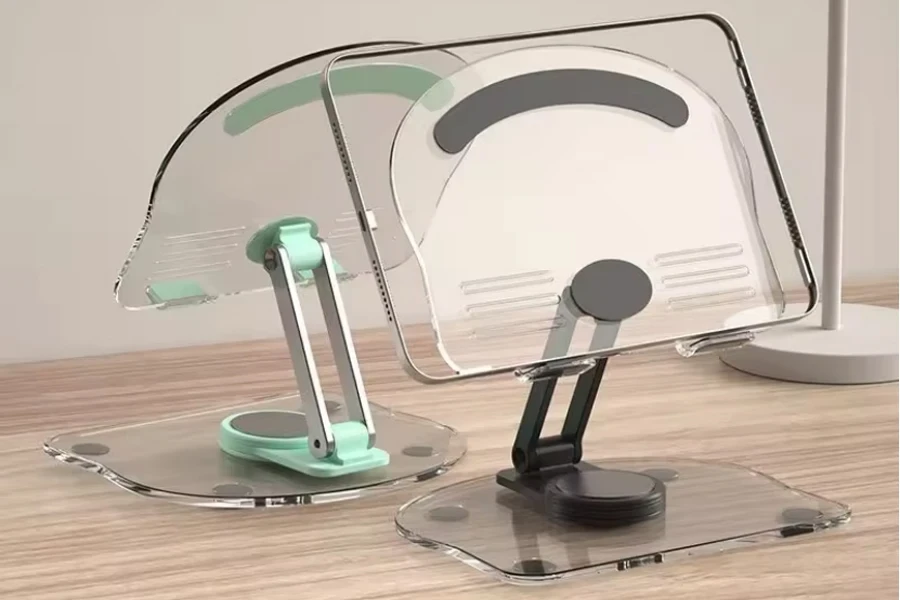
Wooden: Wooden tablet stands emerge as an aesthetically pleasing alternative, adding warmth and a natural touch to any setting. Crafted from bamboo, oak, or walnut, these stands can be both durable and lightweight, with the added benefit of being eco-friendly. Wood’s natural variations in grain and color ensure that each stand is unique, appealing to those who value individuality and craftsmanship. However, wooden stands may require more maintenance to prevent wear from moisture and scratches.
Silicone and Rubber: Silicone and rubber materials are commonly used in parts of the stand that contact the tablet, providing grip and protection against scratches. These materials can also be found in the base of tablet stands, preventing slippage on smooth surfaces. Their flexibility and shock-absorption qualities make silicone and rubber excellent choices for enhancing the stand’s stability and security features.
In summary, the material of a tablet stand significantly affects its functionality, durability, and aesthetic appeal. Metal stands offer robustness and a sleek look, plastic stands provide affordability and versatility, wooden stands bring an organic beauty and sustainability, while silicone and rubber add protection and stability. Understanding the advantages and limitations of each material allows buyers to make informed decisions that align with their specific needs, preferences, and values.
Leading tablet stand models and features

In the landscape of digital device accessories, tablet stands have emerged as indispensable tools for enhancing user experience across various environments and professions. This detailed exploration focuses on the leading tablet stand features designed to meet the needs of professionals, budget-conscious users, and those engaging in specialized activities.
High-performance stands for professionals
Professionals in high-demand environments, such as offices and creative studios, require tablet stands that offer not just stability and durability, but also advanced ergonomic features. These high-performance stands typically incorporate heavy-duty materials that can bear the weight of larger tablets without sacrificing portability. Key features include adjustable height and tilt functions, allowing for the tablet to be positioned at eye level, thereby reducing neck strain during prolonged use. Additionally, these stands might feature swivel bases that enable 360-degree rotation for easy sharing of screen content with colleagues or clients.
PWR+ Adjustable Tablet Stand
The PWR+ Adjustable Tablet Stand is lauded for its versatile design, making it a top pick for anyone looking for a blend of stability and flexibility. This stand distinguishes itself with a 150-degree adjustable mount and 360-degree rotation capability, accommodating devices from 4 to 11 inches in size. Ideal for various environments, from the kitchen to the office, its sturdy build and thoughtful design support your tablet securely, providing a clear view of the screen. Whether you’re video conferencing, reading, or using your tablet as a secondary monitor, the PWR+ stand delivers on both form and function, showcasing why it’s a favored choice among tablet users.
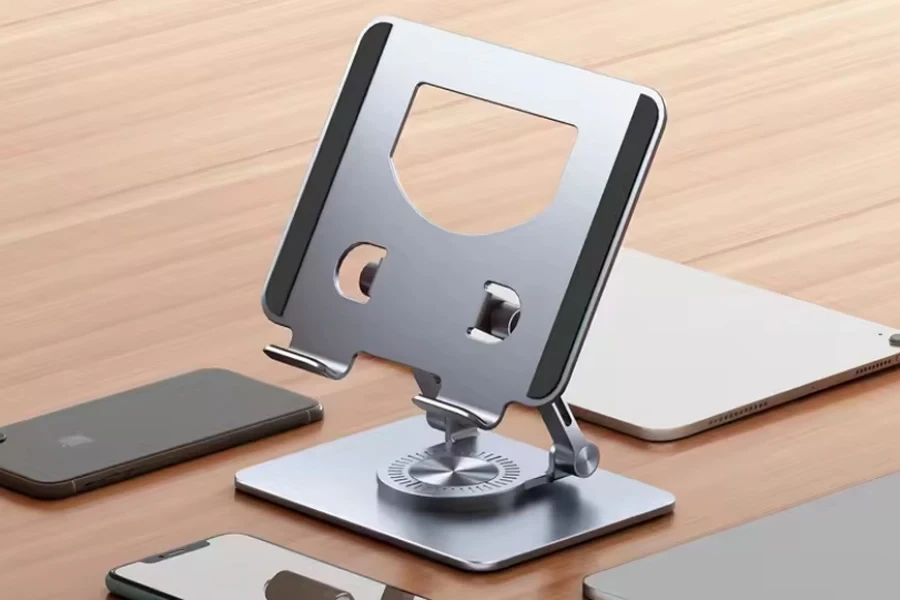
KABCON Quality Tablet Stand
The KABCON Quality Tablet Stand is designed for those who need a robust and adaptable solution for their larger tablets and devices. This stand is notable for its ability to support devices up to 15 inches, making it suitable for almost all tablets, including the larger iPad models. It features height and angle adjustments, providing ergonomic viewing positions that can greatly enhance your productivity, whether you’re drawing, writing, or reading. The stand’s solid construction ensures your device remains stable, while its foldability enhances portability, offering a blend of functionality and convenience for users with larger devices.
SAIJI 360 Rotating Adjustable Stand
The SAIJI 360 Rotating Adjustable Stand is a standout for its unparalleled adjustability and support. It features a heavy base for excellent stability and a telescoping pole that can extend up to 18.1 inches, catering to a wide variety of use cases from video conferencing to presentations. The cradle rotates 360 degrees, allowing for endless viewing angles, and its clamp design securely holds tablets and phones alike. While its size and weight make it less portable than other stands, its versatility and robust design make it a top choice for professional settings where stability and adjustability are paramount.
Budget-friendly choices for everyday use

For individuals seeking functional yet affordable tablet stands, the market offers a plethora of options that ensure value without compromising quality. Budget-friendly stands often make use of cost-effective materials like hardened plastics, combined with a design that supports basic adjustability in viewing angles. Despite their lower price point, these stands are designed to securely hold the tablet for everyday tasks such as web browsing, video calls, or media consumption. Key considerations include the stand’s footprint, ensuring it doesn’t occupy too much desk space, and its ability to fold, which enhances portability.
Lamicall Adjustable Tablet Stand
The Lamicall Adjustable Tablet Stand stands out not only for its sleek, Apple-inspired design but also for its robust aluminum construction. It caters to a wide range of tablets, including large ones like the iPad Pro, ensuring a solid hold without compromising on style. With its ability to adjust to your preferred viewing angle, this stand combines aesthetics with practicality, making it a solid purchase. The high number of positive reviews underscores its reliability and durability, highlighting its popularity in the market. If style and functionality are paramount in your search for a tablet stand, the Lamicall Adjustable Tablet Stand is worth considering.

MoKo Universal Foldable Multi-Angle Stand
For those seeking a budget-friendly yet versatile tablet stand, the MoKo Universal Foldable Multi-Angle Stand emerges as a compelling choice. Lightweight and portable, this stand can be adjusted to six different angles, catering to a variety of viewing needs. Despite its affordability, it doesn’t skimp on functionality, offering a level of flexibility and convenience that’s hard to beat at its price point. Its foldability makes it perfect for on-the-go use, fitting easily into a pocket or bag. Whether you’re reading, browsing, or watching videos, the MoKo stand provides a stable and adjustable platform for your tablet, making it a great addition to your digital setup.
Ugreen Adjustable Tablet Stand
The Ugreen Adjustable Tablet Stand is celebrated for its compact and foldable design, measuring just 4.7 by 4.2 inches when laid flat. This feature makes it exceptionally portable, easily slipping into a pocket or bag. It supports tablets and phones ranging from 4 to 11 inches, with a thickness up to 0.55 inches, showcasing its versatility. The stand can adjust from 15 degrees to 100 degrees, ensuring you get the right angle for viewing or interacting with your device. Its small footprint doesn’t detract from its stability, making it a reliable stand for users who are always on the move.

Amazon Basics Adjustable Tablet Stand
Amazon Basics Adjustable Tablet Stand offers an affordable yet functional solution for tablet users. This stand is foldable and lightweight, promoting ease of portability for individuals on the go. Despite its budget-friendly price, the stand doesn’t compromise on versatility, accommodating a range of tablet sizes with its adjustable width and angle settings. Its simple design includes a fold-out mechanism that allows for quick setup and adjustment, making it an ideal stand for users seeking simplicity and functionality without a significant investment.
Stands designed for specific activities
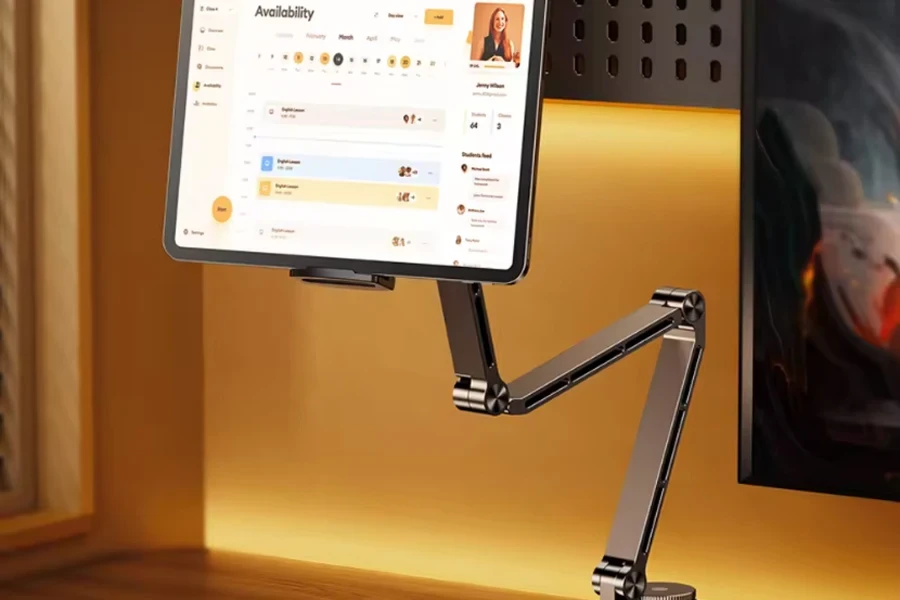
Specialized tablet stands cater to users with specific needs, such as artists requiring a stand that mimics an easel for digital drawing or chefs needing a stand that can withstand the rigors of a kitchen environment. These stands often feature unique design elements, like water-resistant materials for kitchen use or stands with extended arms that can be adjusted to hover over a work surface, perfect for illustrators and designers. Additionally, stands with modular components that can accommodate additional accessories, such as lights or microphones, are particularly beneficial for content creators who use their tablets as an integral part of their production setup.
Tablift by Nbryte
The Tablift by Nbryte introduces a unique solution for tablet users seeking versatility and stability, especially on uneven surfaces like beds or couches. With its gooseneck legs, the Tablift can be adjusted to various positions, offering an unparalleled level of adaptability. This stand allows users to comfortably watch videos, read, or browse the internet in bed, without the need for balancing acts or uncomfortable positions. Its innovative design may be bulkier compared to other stands, but it excels in providing a stable and eye-level viewing experience, making it an ideal choice for leisurely use at home. The Tablift by Nbryte stands out as a niche, yet highly practical tablet stand solution.

Magipea Gooseneck Tablet Holder
The Magipea Gooseneck Tablet Holder stands out with its sturdy yet flexible design, featuring a 30-inch aluminum-magnesium alloy arm that can be bent into various shapes for optimal viewing. This gooseneck holder is designed to support devices in a wide range of sizes, making it versatile for different tablet models. Its strong clamp can attach to surfaces up to 3 inches thick, offering secure attachment to desks, bed frames, and other furniture. Ideal for hands-free use in bed, at a desk, or in the kitchen, the Magipea Gooseneck Holder provides users with the flexibility to enjoy content or conduct video calls without holding their devices.
Ontel Pillow Pad Tablet Stand
Unique in its category, the Ontel Pillow Pad Tablet Stand combines comfort with convenience, featuring a soft foam and fabric design. This stand offers three different viewing angles, adapting to your needs whether you’re reading in bed, browsing on the couch, or watching videos. It includes a side pocket for accessories or personal items, enhancing its functionality. The lightweight and portable design of the Pillow Pad makes it an excellent companion for both home and travel, providing a cozy support for your tablet in various settings.
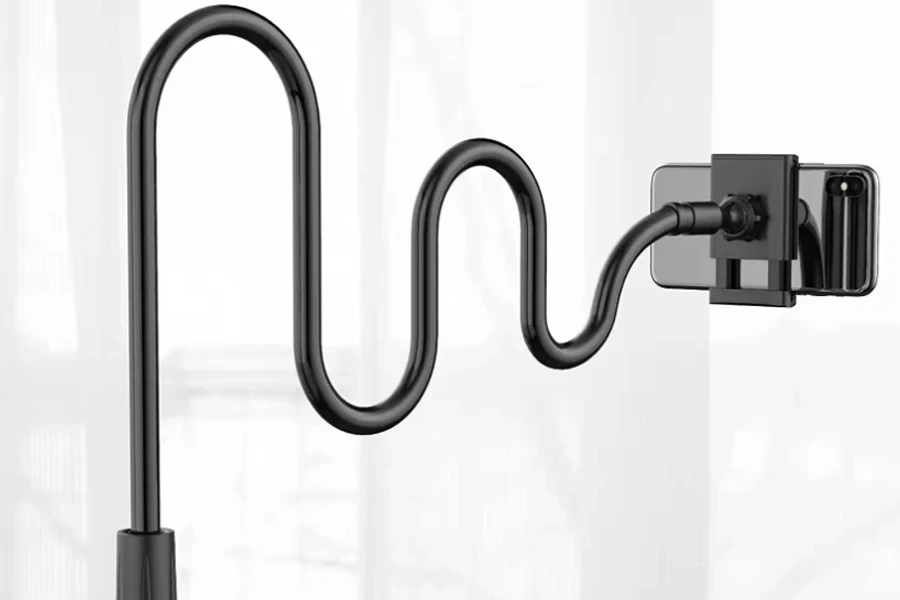
The diversity in tablet stand design reflects the wide array of use cases for tablets today. From enhancing productivity in professional settings to supporting hobbies and content creation, the right tablet stand can significantly improve the user experience. For buyers, understanding the specific features that align with their needs—whether it’s for high-performance professional use, budget-friendly options for general tasks, or specialized stands for unique activities—is key to making an informed decision that maximizes both functionality and value.
Conclusion
Selecting the right tablet stand in 2024 transcends mere preference; it involves making a strategic choice that aligns with both personal and professional requirements. This selection process, informed by a comprehensive understanding of the stand’s features—ranging from compatibility and flexibility to stability, security, and ergonomic benefits—ensures that users can leverage the full potential of their digital devices. Whether for high-demand professional environments, budget-conscious consumers, or specialized activities, the ideal tablet stand enhances the tablet experience, merging functionality with lifestyle or work demands.




